Use of poplars and willows for erosion control
Garth Eyles, New Zealand Tree Grower November 2010.
If I had to choose the ideal tree for erosion control on a hill country sheep or beef unit it would need to −
- Grow in the presence of the grazing animal
- Not significantly reduce pasture growth
- Reduce the risk of soil erosion
- Provide fodder
- Provide shelter and shade
- Produce timber
- Sequester carbon.
The ideal tree does not exist, but it almost does in the form of poplars and, to a lesser extent, willows. In many countries, poplars are a major source of timber but in New Zealand the use of poplars has been restricted to erosion control purposes. Partly this has been because poplars and willows were bred by Ministry of Works for erosion control use while the Forest Service concentrated on radiata pine for timber. Professionally, there was little mixing of the two objectives. Only the erosion control aspects of poplars and willows have so far been accepted by many farmers. However, their use as drought fodder has been a saviour for many farmers, as has been indicated by previous articles in this magazine.
There is a small but growing market for poplar timber. For instance, in Hawke’s Bay it is exported to Indonesia and shipments have gone to China. Poplars could also be the ideal tree for hill country carbon farming, but more about this later.
Erosion control
Poplars and willows were introduced for erosion control in pastoral hill country because they were the only trees that could be grown from poles and therefore could be planted in pasture without retiring the whole paddock. Researchers in the 1960s developed effective tree protectors allowing continued access for sheep and light cattle. Poplar and willow breeding programmes have concentrated on possum resistance, rust resistance and specific site requirements, as the trees were expected to grow in very marginal environments. The result has been a range of clones which will grow in a range of environments.
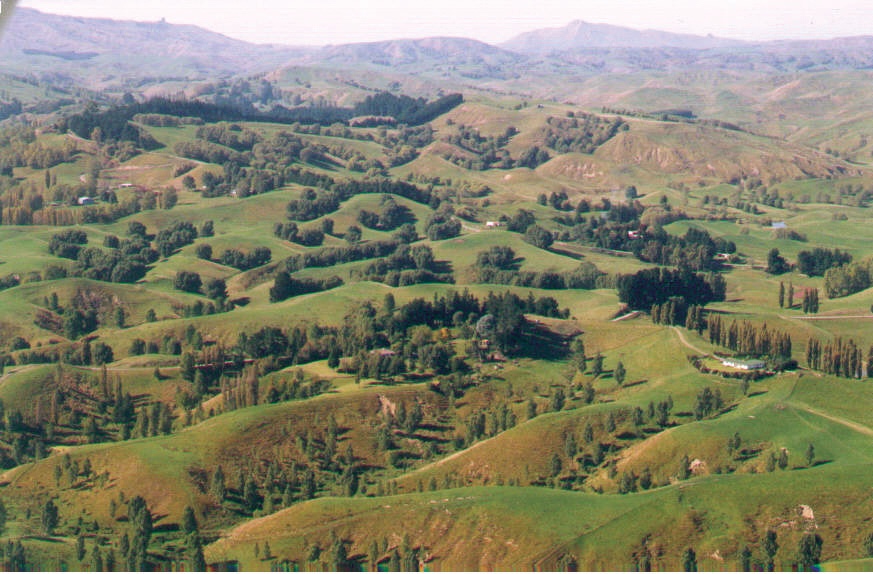
Before deciding on what type of poplar or willow to plant it is advisable to consult with your local land management advisor. These are one of the few free advisory services remaining, so make use of them. This consultation is important as different clones can be site specific and many sites are very marginal. It is a waste planting a catchment only to have most trees die because of a spring drought or possum damage. Select the correct material for each site and where possible plant a mix of clones.
Planting material
The vast majority of poplars and willows are planted as poles. Quality poles grow well, poor quality poles are more likely to struggle. Therefore wherever possible buy poles from a nursery where quality control can be assured. For example in Hawke’s Bay it was found that poles which had been exposed to any rust in the nursery did not establish or grow well in the field. A comprehensive spraying programme in the nursery has now minimised this risk.
Before buying, check that the pole −
- Has not been exposed to rust or other disease
- Is harvested within two years
- Is three metres long and 50 to 75 mm in diameter at the butt end and a minimum of 25 mm at the upper end
- Is straight because crooked poles cannot be rammed
- Is well hydrated and weighs five to six kilos
- Has no damage to the bark.
On delivery, poles must be stored in clean running water or a damp shady site before planting. Do not let them dry out and do not leave too long in the water – one to two weeks is the maximum. Rooted cuttings establish well in harder sites but these sites need to have been retired from grazing. Usually rooted cuttings can only be obtained from commercial nurseries.
Planting
Planting technique is critical for survival. There are two techniques, ramming and digging. With both techniques it is essential to −
- Plant the pole at least 600 to 700 mm deep
- Compact the soil around the pole and keep it compacted throughout the year
- Plant in moist sites
- Ensure the protector stays in place – staple Netlon sleeves top and bottom
- Not damage the bark as this will let disease get established.
During the first year check the poles a number of times to make sure they remain tight, as loose poles break new roots and allow the pole to dry out. If planting in clay soils it is essential to check regularly, as these soils shrink and swell considerably.
Planting to prevent erosion
Slip erosion
Where slips are likely to occur, plant poles at a regular 15 metre by 15 metre spacing across the slope. On most sites slopes over about 15 degrees can slip, but check for old slip scars as these will give an indication as to where slipping is likely. Remember, previously cultivated slopes can mask past erosion.
Plant on the upper parts of slopes above the slip scars as well as the mid slope slip sites as, over a period of time, slips tend to move up the slope. Frequently planting is concentrated on the slip debris sites on the lower slopes, but this is generally a waste of time as these sites will not slip again. However, on mudstones this deposition material may flow in the future and so needs to be space planted. By careful site selection as few as 15 poles per hectare may be sufficient on slip prone hill country.
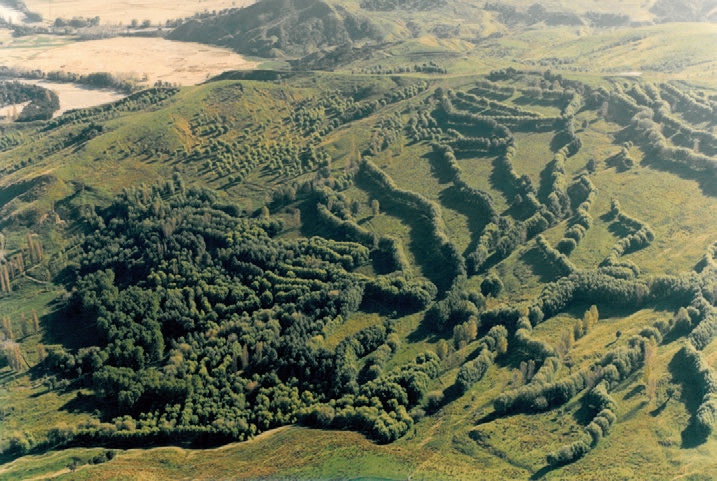
Earth flow erosion
Earth flows occur mainly on mudstones and shattered argillites, although they can also occur on schist country. Fault zones are often recognised from earth flows where they would normally not be expected. Earth flows generally start moving late in the winter, after the whole profile has been thoroughly wetted. They generally do not move during high intensity rainstorms unless the subsoil is already saturated. In southern Hawke’s Bay, earth flows did not move for a decade in the 1990s but started again after a number of consecutive wet summers and winters.
Earth flows come in two general types, shallow ones which are less than one to two metres, and deep ones which can be 70 metres or more in depth. They are caused by the material under the turf mat becoming liquid or losing strength when saturated and flowing down-slope under the turf. With shallow movements the flow is constrained to between the turf mat and the unweathered rock. Control depends on the size and depth of the earth flow, the underlying rock type, the rate of movement and the degree of gullying or undercutting of the base.
Only experience can identify whether the movement is repairable so that grazing can continue, or whether it needs to be retired and close planted. For those earth flows that are repairable, a combination of re-contouring, de-watering and planting of willows or poplars is needed.
Preferably remove all dams, as these can lubricate flows, and ensure run-off can move freely and not bank in hollows or behind banks. Once this is done, space plant willows or poplars at regular 15 by 15 metre spacing across the slope. Planting on the contour will allow for easier pasture and stock management and future pasture renewal. Willows are effective on earth flows as they have fibrous roots but they need more management than poplars to control splitting and branch breaking.
Earth flow movement can be accentuated by concentrated water cutting through the broken soil, forming gullies. These over-steepen the flow increasing the rate of movement. This incipient gullying needs to be stopped by pair and block planting of willows. In addition earth flow movements can be made worse by undercutting of the earth flow by bank erosion or tracking. Where this occurs, the base needs to be retired and block planted in willows at about one metre spacing. Surprisingly this does slow up and even halt movement.
Gully erosion
Gully erosion occurs where concentrated water flows scour the soil down to bedrock, usually during high intensity storms. In soft or shattered rock environments the rock material continues to be scoured. This lowers the base level, causing side wall collapse and enlargement of the whole gully system.
The most common gullies occur when water scours out a valley bottom. These can be controlled by pair planting willows along the valley bottom at about 10 to 15 metres apart. The willow roots form mats under the waterway and on the side walls reducing the risk of further degradation and protecting the banks. These are often planted in conjunction with small debris dams to raise the bed level. This in turn, lowers the slope angle of the side slopes which can then be stabilised by spaced plantings.
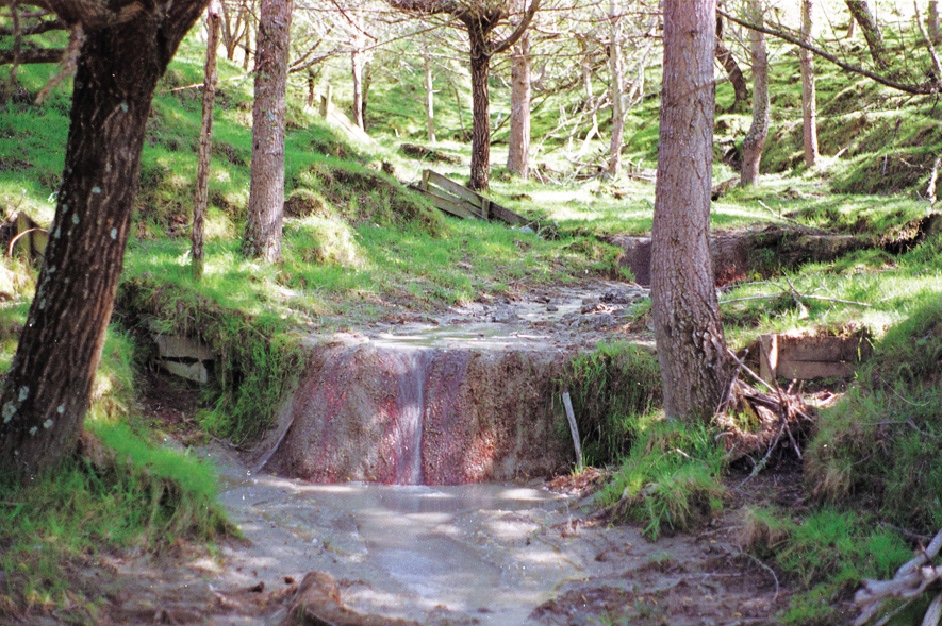
Large and deep gullies, such as those in the East Cape area, need retiring with close planting in willows on the most eroded areas and radiata pine on the remainder of the slopes and surrounding catchment areas. These will take many decades to control.
Tunnel gully erosion
Tunnel gully erosion occurs when subsurface flows are concentrated, removing soil particles as the water moves down the slope. This process creates tunnels which can collapse forming tunnel gullies. Although not generally considered a problem by farmers, many lambs and even sheep losses occur. By planting poles in the holes or along the hollows, the tunnels gradually fill up.
Frequently, erosion types occur in association with each other, such as, earth flow and gully erosion. In these cases take advice from your local land management advisor and work together to plant poplars and willows in the most critical spots. These plantings will often halt the erosion.
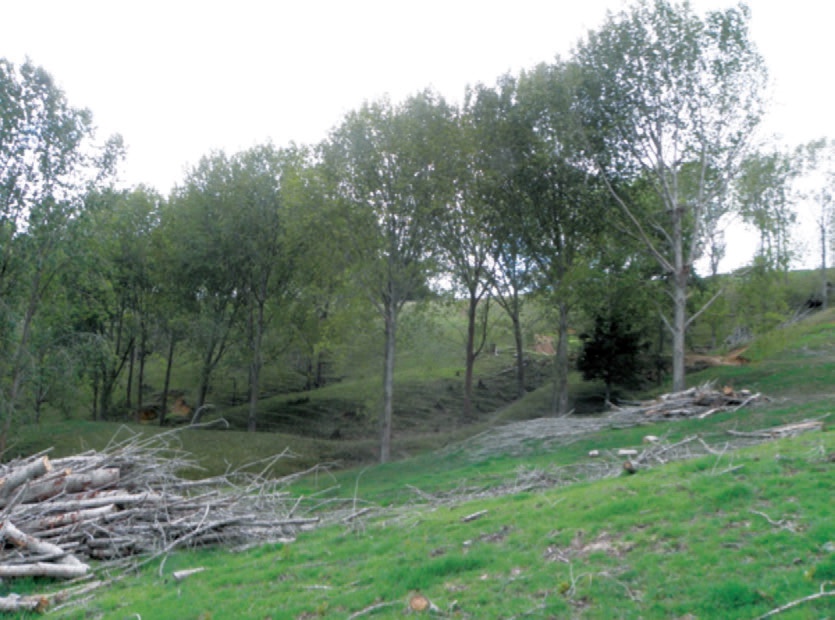
Post planting management
Like any trees, poplars and willows need managing to make sure they do not create problems as they mature. One of the perceived difficulties with poplars and willows is what to do as they get older.
Unlike radiata pine, which is generally harvested before it becomes over-mature, poplars and willows are generally not harvested. However they should be pollarded to make sure they remain healthy and useful trees. The modern two-tier farmer needs to be an expert with a chainsaw.
Every few years each tree needs to be inspected for broken or diseased branches which should be removed, with the lower branches pruned to reduce shading around the trunk. This encourages stock to move around the tree for shade rather than sitting under it. This work can be done in the summer dry periods, providing supplementary fodder.
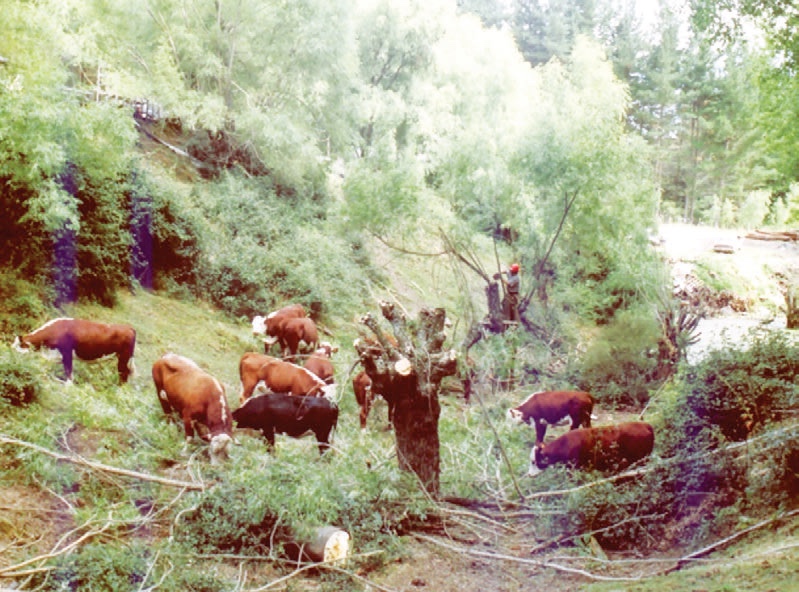
Carbon farming
Poplars provide the opportunity for farmers to farm carbon and meat farm on the same site while reducing the erosion risk. This could be a major advantage to hill country farmers as they can continue grazing, have a supply of drought fodder, and grow carbon.
The requirement for carbon farming is to have a 30 per cent tree canopy cover. If a slope is space planted in poplar, after 12 years each tree could be expected to have a canopy with a five metre radius canopy, giving a canopy area of just under 80 square metres. This means that to achieve 30 per cent ground cover, no more than 40 trees would be needed for each hectare, a spacing of about 19 metres.
Because the trees would be used for drought fodder, a 60 per cent ground cover would be advisable to allow for the losses when pollarding. This would require around 80 trees per hectare. Careful tree selection could provide a profitable combination of pastoral production, carbon farming and drought fodder.

 Farm Forestry New Zealand
Farm Forestry New Zealand